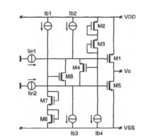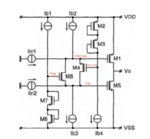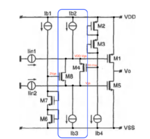m_kuty
Member level 2
Hi everyone
from textbook, the schismatic as attached is class-ab, and mention the minimum supply voltage. what dose mean that, and which transistor referring by
The minimum supply voltage of the output stage equals two stacked gate-source voltages and one saturation voltage, which makes it suitable for low-voltage operation.

from textbook, the schismatic as attached is class-ab, and mention the minimum supply voltage. what dose mean that, and which transistor referring by
The minimum supply voltage of the output stage equals two stacked gate-source voltages and one saturation voltage, which makes it suitable for low-voltage operation.


